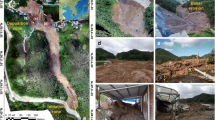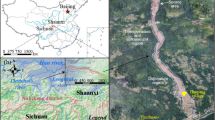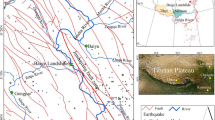Abstract
On July 23, 2019, a large catastrophic landslide was triggered by heavy rainfall at Jichang Town, Shuicheng County, Guizhou, China. This high-speed landslide was characterized by a short slip time, long slide distance, and great destructiveness. In less than 2 min, about 2 million m3 of cataclastic basalt soil failed with a runout of about 1.25 km over a total vertical distance of about 465 m. The landslide destroyed 21 houses and caused 42 fatalities with 9 people missing. To understand the possible mechanisms for the high-speed and long-runout behavior of the landslide, a detailed field survey was conducted. A preliminary analysis was performed on the movement characteristics and formation mechanism of the landslide based on combining data from multitemporal optical satellite remote sensing images, aerial photography from an unmanned aerial vehicle, and InSAR. The historical remote sensing images, InSAR results, and geological monitoring data indicated no obvious deformation signs before the landslide, which implies that it occurred suddenly. The landslide was probably primarily induced by heavy rainfall, while the direct impact of road excavation was small. The terrain controls motion characteristics of the landslide and air blast effect is still visible at the leading edge of the landslide. The results of this study may provide basic data for further research on the mechanisms for landslide initiation and movement.



















Similar content being viewed by others
References
Bayer B, Simoni A, Schmidt D, Bertello L (2017) Using advanced InSAR techniques to monitor landslide deformation induced by tunneling in the Northern Apennines, Italy. Eng Geol 226:20–32
Crosta GB, Imposimato S, Roddeman DG (2003) Numerical modelling of large landslides stability and runout. Nat Hazards Earth Syst Sci 3:523–538
Ekstrom G, Stark C (2013) Simple scaling of catastrophic landslide dynamics. Science 339:1416–1419
Geological survey institute of Guizhou province (2016) Description of regional geological maps of Jichang town with the scale of 1:50,000 (in Chinese)
Guizhou meteorological bureau (2019) Liupanshui: check the past meteorological data of the landslide site, and the chief forecasters of the municipal meteorological bureau study the future weather trend together, July 25, 2009. (URL: http://gz.cma.gov.cn/xwzx/qxyw/201907/t20190725_939861.html) (in Chinese)
Huang R (2009) Some catastrophic landslides since the twentieth century in the southwest of China. Landslides 6(1):69–81. https://doi.org/10.1007/s10346-009-0142-y
Legros F (2002) The mobility of long-runout landslides. Eng Geol 63(3–4):301–331
Nishiguchi T, Tsuchiya S (2017) Detection and accuracy of landslide movement by InSAR analysis using PALSAR-2 data. Landslides 14(4):1483–1490
Riedel B, Walther A (2008) InSAR processing for the recognition of landslides. Adv Geosci 14:189–194
Schlogel R, Doubre C, Malet J, Masson F (2015) Landslide deformation monitoring with ALOS/PALSAR imagery: a D-InSAR geomorphological interpretation method. Geomorphology 231:314–330
Seismological Bureau of Guizhou Province (2019) Special report on non-natural earthquake event – technical report on the landslide event in Shuicheng, Guizhou Province on July 23 2019. Seismological Bureau of Guizhou Province, Guiyang (in Chinese)
Watkins JA, Ehlmann BL, Yin A (2015) Long-runout landslides and the long-lasting effects of early water activity on Mars. Geology 43(2):107–110
Xu Q, Fan X, Huang R, Yin Y, Hou S, Dong X, Tang M (2010) A catastrophic rockslide-debris flow in Wulong, Chongqing, China in 2009: background, characterization, and causes. Landslides 7(1):75–87. https://doi.org/10.1007/s10346-009-0179-y
Xu Q, Shang Y, van Asch TWJ, Wang S, Zhang Z, Dong X (2012) Observations from the large, rapid Yigong rock slide–debris avalanche, Southeast Tibet. Can Geotech J 49(5):589–606. https://doi.org/10.1139/t2012-021
Xu Q, Li W, Dong X, Xiao X, Fan X, Pei X (2017) The Xinmo landslide on June 24, 2017 in Maoxian, Sichuan: characteristics and failure mechanism. Chin J Rock Mech Eng 36(11):2612–2628
Yin Y, Xing A (2012) Aerodynamic modeling of the Yigong gigantic rock slide-debris avalanche, Tibet, China. Bull Eng Geol Environ 71(1):149–160. https://doi.org/10.1007/s10064-011-0348-9
Yin Y, Wang H, Gao Y, Li X (2010) Real-time monitoring and early warning of landslides at relocated Wushan Town, the Three Gorges Reservoir, China. Landslides 7(3):339–349. https://doi.org/10.1007/s10346-010-0220-1
Yin Y, Sun P, Zhu J, Yang S (2011) Research on catastrophic rock avalanche at Guanling, Guizhou, China. Landslides 8(4):517–525. https://doi.org/10.1007/s10346-011-0266-8
Yin Y, Xing A, Wang G, Feng Z, Li B, Jiang Y (2016) Experimental and numerical investigations of a catastrophic long-runout landslide in Zhenxiong, Yunnan, southwestern China. Landslides 14(2):649–659
Zeng Q, Wei R, Xue X, Zhou Y, Yin Q (2018) Characteristics and runout mechanism of super-large Xinmo rock avalanche-debris flow in Diexi, Sichuan province. J Eng Geol 26(1):193–206 (in Chinese)
Zhang Z, He S, Liu W, Liang H, Yan S, Deng Y, Bai X, Chen Z (2019) Source characteristics and dynamics of the October 2018 Baige landslide revealed by broadband seismograms. Landslides 16:777–785
Zhou J, Cui P, Hao M (2016) Comprehensive analyses of the initiation and entrainment processes of the 2000 Yigong catastrophic landslide in Tibet, China. Landslides 13:39–54
Acknowledgments
We express our gratitude to Jie Dang and Liang Yang from the Guizhou Geological Environment Monitoring Institute for providing some field investigation materials.
Funding
This study was financially supported by the Foundation for Innovative Research Groups of the National Natural Science Foundation of China (Grant No. 41521002) and Foundation of the State Key Laboratory of Geohazard Prevention and Geoenvironment Protection (Grant No. SKLGP2018Z014).
Author information
Authors and Affiliations
Corresponding author
Rights and permissions
About this article
Cite this article
Zhao, W., Wang, R., Liu, X. et al. Field survey of a catastrophic high-speed long-runout landslide in Jichang Town, Shuicheng County, Guizhou, China, on July 23, 2019. Landslides 17, 1415–1427 (2020). https://doi.org/10.1007/s10346-020-01380-z
Received:
Accepted:
Published:
Issue Date:
DOI: https://doi.org/10.1007/s10346-020-01380-z




